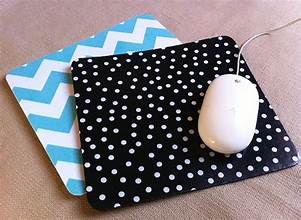Using a mouse without a mousepad can be a frustrating experience. As you try to move the mouse, you may find that the cursor skips or freezes more often if you’re not using a mousepad. High-quality mousepads can get expensive, leading many people to wonder if they can use household items instead.
Here are 11 common items that you can use as a mousepad:
- Cardboard or cardstock
- Duct tape
- Newspaper/magazine
- Dining placemats
- Manilla folder or envelopes
- Butcher’s paper
- Hardback books
- Stretched fabric
- Corkboard or foamboard
- Notebook or legal pad
- The clothes on your body
Mousepads can dramatically improve your digital dexterity, which makes it additionally frustrating when you find yourself without one. Keep reading for more information about how to use household items as mousepads, as well as some extra information about the function that mousepads serve to the overall user experience.
1. Cardboard or Cardstock
Cardboard can make a highly effective mousepad, and it’s easy to find around the home or office. WikiHow recommends using corrugated cardboard rather than flat, smooth cardboard to allow a layer of cushioning between the mouse and desk or table surface.
The smooth surface of corrugated cardboard makes an effective mousepad for either a rolling ball or a laser optical computer mouse. The advantage of cardboard is that the surface is smooth and even without being glossy. For this reason, avoid heavily laminated or sealed materials, as the light reflection off the lamination may interfere with the mouse’s motion-tracking ability.
The standard size specifications for mousepads are 8 inches by 10 inches (20.32 by 25.4 cm), but you can cut your cardboard mousepad to whatever size suits your workspace best. You can modify the thickness of your mousepad by gluing layers of cardboard together to achieve your desired elevation off the desk surface.
2. Duct Tape
Duct tape is also smooth without being too reflective, which makes it an appealing option for a DIY mousepad. It can be used to make a mousepad either by wrapping the tape around another surface—such as a segment of corkboard—or by layering strips of tape over each other to make a woven mat.
The potential risk of using duct tape is the gluey underside, which can gum up the mechanisms of the mouse if left exposed. Because the mouse will be constantly moved and dragged over the surface of the mousepad, any exposed corners or imperfect layer edges of a duct tape mousepad are likely to be pulled and turned up.
3. Newspaper or Magazine
If you’re looking for a quick fix, a newspaper or magazine can serve as an effective mousepad. If you’re using a magazine, be sure to choose one that isn’t printed on too glossy pages. Newspapers tend to be a safer bet, as the newsprint generally is less reflective.
The advantage of using newspapers or magazines, according to The Life Hype, is that they can typically be found in almost any setting. This means that if you’re stranded in need of a mousepad, all you have to do is find a spare newspaper or magazine lying around. This is especially helpful in waiting rooms and airports, where surface space and materials are harder to find.
4. Dining Placemats
Dining placemats can be used as a mousepad, depending on the material of the placemat. Silicon or rubber placemats are effective, as well as easy to clean. If you use a placemat for your mousepad, be sure to clear it of all food debris before using your mouse on it.
Cloth placemats can also be effective mousepads. Be sure to use placemats with a smooth texture, and ensure that the placemat is weighted down for optimal use. They may tend to move or fold under the motion of the mouse, which can interfere with the motion sensors.
5. Manilla Folders or Envelopes
Large manilla folders or envelopes are useful as make-shift mousepads as well. The texture and weight of the pulp used to make these types of envelopes make for a smooth, readable surface. This is ideal for the mouse to pick up the slightest motion, improving the relative responsiveness of the cursor.
Manilla folders are a commonality in many home and office supply closets, which makes them a dependable option in case you need a mousepad right away. Other types of folders or envelopes can work as well; however, the standard size of manilla envelopes is much larger than traditional or legal envelopes. This provides additional mobility for the mouse.
6. Butcher’s Paper
Butcher’s paper, oven sheets, or other forms of wax paper can also be effective mousepads. When using wax paper to make a mousepad, you’ll need to make sure the paper doesn’t move under your mouse. You can achieve this either by tacking the paper down to another base material or securing it to the surface of your workspace.
7. Hardback Books
Hardback-bound books can serve the same purpose as a mousepad if needed. Larger books, such as textbooks or cookbooks, provide the user with more room to move the mouse.
Some hardback books have a glossy sheen on the cover, which can cause issues for the motion sensors on the underside of the mouse. If you encounter this problem, try opening the book and using the mouse on one of the body pages.
Fabric makes for a good mousepad, as long as you can keep it smooth and stationary. This can be done by stretching the fabric taut across a board or frame, similar to stretching canvas over a painter’s frame. The mousepad is likely to be more effective if stretched over a solid board than a hollow frame, however.
You can use almost any fabric, such as an old sheet or pillowcase, to make your DIY mousepad. If you’re feeling creative, you can even head down to the art-and-craft supply store and pick out a special color or patterned fabric to personalize your mousepad.
9. Cork Board or Foam Board
If you’re getting artsy with your DIY mousepad, there are a few easy materials to use. Corkboard, which is the springy wood material used in bulletin boards, provides an excellent cushion surface between the mouse and desktop.
You can buy segments of corkboard from a supply store or cut out a section from an out-of-use bulletin board if you have one on hand. Foam board or poster board can also be effective if a cork board isn’t available. These materials are relatively inexpensive and easily customizable, which makes them a popular option for DIY projects.
A standard spiral notebook, composition book, or legal pad can be used to fill in for a mousepad in the event you find yourself without one. The advantage of notebooks is that they typically have a cardboard backing to support the weight of the paper. This comes in handy if you’re using them as mousepads.
If you have space to do so, you put the notebook or pad down with the cardboard bottom facing up. This will provide the best surface for the computer mouse to travel on, as the desktop provides a level foundation for the cardboard “mousepad” surface.
If you’re working on the go, however, you can put the notebook or pad on your leg with the cardboard side down, moving the mouse across the surface of one of the pages. This will provide the best support, creating a relatively level surface on your leg for the mouse to measure against.
11. The Clothes on Your Body
The very clothes that you’re (hopefully) wearing can, in a pinch, be used to create a mousepad-like surface area. This typically works best if you’re wearing tight-fitting clothes, as there will be fewer folds and wrinkles to interfere with the mouse’s sensors.
Are Mousepads Necessary?
As the nature and design of computer mice continue to get more advanced, many users may be wondering if they can do without a mousepad. How much easier would it be if you could just move your mouse over your desk or tabletop, right? Mousepads serve an important purpose, however.
Mousepads aren’t strictly necessary for your mouse to function, but they can help optimize the experience. A mousepad essentially provides a smooth, even space for the mouse to accurately measure the user’s movement. That means the cursor will move smoother and be more responsive to the mouse.
Choose the Right Material for Your Improvised Mousepad
Mousepads can be expensive, ranging from $10 to $80 or higher, according to Tech User’s Guide, so some consumers choose to make their own using household materials.
There are a variety of different materials you can use to improvise a mousepad, and most of them can be found around the house. It’s important to choose your materials carefully, as the mouse will work better on some types of surfaces than others. The best materials for mousepads should be smooth and level but not too slick or glossy.
Hard Mousepads vs. Soft Mousepads: What Kind of Mousepad Does Your Mouse-Type Need?
Two main categories of mousepads are industrially produced, according to Chron: hard and soft. These are manufactured to meet the needs of whatever type of mouse you have. There are two main types of computer mice: rolling ball and optical laser.
Older generations of computer mice operated using rolling-ball technology. These types of mice require a soft mousepad to function at peak efficacy. Because the function of the mouse is dependent on the ball physically rolling across the measuring surface, the material of the mousepad is all the more critical.
If you have an older, rolling ball mouse, you’ll want to use a soft-material mousepad, such as rubber or silicone. Laser optical mice, however, use more advanced, accurate, and responsive technology, which allows for the mouse to be effective on either hard or soft mousepads.
Materials To Avoid When Making an Improvised Mousepad
- Glass surfaces or hand mirrors: These items are much too reflective and can cause issues with newer model mice.
- Polished wood: You’ll have the same issue with polished wood: It’s too reflective.
- Desktop or tabletop: While some desktops/tabletops may be okay to use, others will be made of scratchy or bumpy material. Some are also too reflective. Finally, some are just too slick. It’s best to have something between your mouse and the tabletop if possible.
- Too loose, baggy, or soft fabric: The mouse won’t roll right on this kind of fabric; it needs to be stretched tight.
Stay away from those few things, and you should be just fine.







